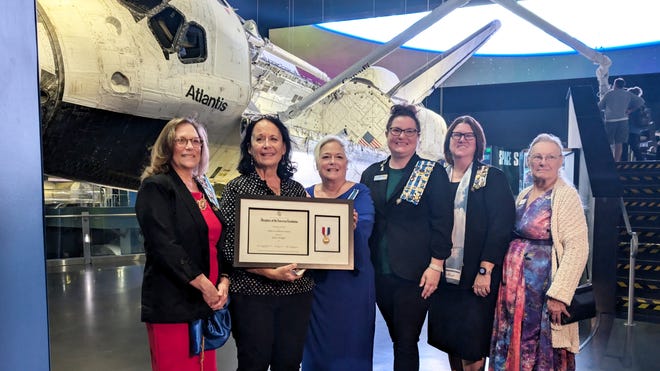NASA seamstress accepted by DAR for shuttle work
Jean Wright’s sewing career was unusual: “Sister Sew” had a mission to keep NASA’s Space Shuttle and its astronauts safe.
He sewed with materials that could withstand temperatures of up to 3,200 degrees.
On Thursday afternoon, Wright stood next to the Space Shuttle Atlantis on display at the Kennedy Space Center Visitor Complex, explaining to members of the Daughters of the American Revolution (DAR) his important work on the vehicle.
The warm blankets he once painstakingly sewed – by hand and by machine – protected the spacecraft and its crew from the heat of re-entry into Earth’s atmosphere. DAR members listened in awe as they presented Wright with the DAR Women in American History award in recognition of her work.

Many would think that the exterior of the space shuttles was all metal. It wasn’t like that. They were two inch thick blankets covered with a ceramic blanket. These blankets, made of quartz fiber, acted as thermal insulation, keeping the shuttle safe from the high temperatures encountered during re-entry.
“Ms. Wright is being honored with the DAR Women in American History award for her exceptional talents and contributions as a thermal protection specialist and NASA seamstress working on the space shuttle program,” said Suzy Mulligan, assistant of the deputy of the Fairfax Country Chapter.
When is Florida’s next announcement?Is there an offer today? SpaceX, NASA’s upcoming rocket launch schedule from Florida
The award came about when Mulligan saw the book, “Sew Sister”, written and illustrated by Elise Matich, and highlighting Wright’s work as a NASA seamstress.
Wright was one of 18 women who sewed blankets for NASA’s space shuttles (Atlantis, Endeavour, and Discovery) before retiring in 2011. She also worked on parachutes and skirt blankets for spaceflight. of Orion, which is intended to carry astronauts around. moon by the end of 2025 as part of NASA’s Artemis program.

“The National Society of Daughters of the American Revolution is proud to recognize women who have made a difference in their communities, their country and around the world,” said Mulligan. He told the audience that other female aviators known to the public include Sally Ride, Mae Jemison and Amelia Earhart.
Wright told FLORIDA TODAY that in the nose of the spaceship, which took a lot of heat, there were “puzzle blankets.” Named for their appearance, Wright sewed them using a thread made from a bright pink material called AB 440, which could withstand temperatures of 3,200 degrees.
In total, one blanket lasted 18 hours and was good for three flights. When they were finished, the blankets were covered with ceramic cloth.
Wright even kept a notebook detailing every piece she ever sewed. He told FLORIDA TODAY that if anyone ever had a question about an episode, the answer could be found in his diary.
And he can tell the wear of the blankets and tiles on the ship, explaining that in flight the blankets darkened while the tiles brightened.
Wright said she had no idea she could use her sewing skills at NASA when she moved to Cape Canaveral. A space enthusiast since the Apollo 11 moon landing, he wanted to contribute to NASA but didn’t know how. Around the same time, she saw an article in FLORIDA TODAY that featured a photo of NASA seamstress Pilar Valdivieso working on space blankets.
“I’m really honored to be a very important person with the people they listed,” Wright said. “When they told me I was getting an award, and I saw the names, I said ‘What I did was important, but I don’t know if I measure up there'”.
Add rockets to any room:Is there an offer today? SpaceX, NASA’s upcoming rocket launch schedule from Florida
Today, Wright enjoys sharing his knowledge about the space shuttle as a caretaker at the Visitor Complex, and working with his partner, Ken Kremer, on their blog Space UpClose.
Brooke Edwards is a Local Reporter for Florida Today. Contact him at bedswards@floridatoday.com or at X: @brookeofstars.
#NASA #seamstress #accepted #DAR #shuttle #work
